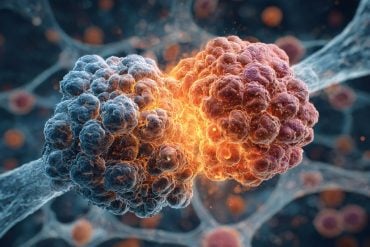Summary: Breast milk is more than nourishment—it delivers circadian cues that may shape infant sleep, immunity, and metabolism. Researchers analyzing milk samples found that melatonin peaked at night and cortisol in the early morning, while other immune-related proteins remained steady.
Infants younger than one month received higher concentrations of protective compounds such as IgA and lactoferrin. These findings suggest that timing expressed milk feedings to match when the milk was pumped could enhance natural developmental support.
Key Facts
- Circadian Signals: Melatonin and cortisol in milk rise and fall across the day.
- Age-Dependent: Protective compounds like IgA are highest in the first month of life.
- Practical Use: Labeling milk by expression time may optimize its benefits.
Source: Frontiers
Breast milk is the first ‘super food’ for many babies. Full of vitamins, minerals, and other bioactive compounds, it helps build the young immune system and is widely considered the optimal source of infant nutrition.
Not all mothers, however, have the opportunity to directly breastfeed multiple times during the day and night, and might use expressed milk stored for later.
Breast milk delivers a variety of cues from the mother to the infant, including signals that are thought to influence babies’ circadian rhythms. The hormones and proteins involved in circadian signaling, however, may vary in breast milk concentration over 24 hours. To learn more about these fluctuations, researchers in the US investigated expressed breast milk samples taken during different times of the day.
They published their findings in Frontiers in Nutrition.
“We noted differences in the concentrations of bioactive components in breast milk based on time of day, reinforcing that breast milk is a dynamic food. Consideration should be given to the time it is fed to the infant when expressed breast milk is used,” said first author Dr Melissa Woortman, a recent PhD graduate from the Department of Nutritional Sciences at Rutgers University.
“The timing of these cues would be particularly critical in early life, when the infant’s internal circadian clock is still maturing,” added senior author Prof Maria Gloria Dominguez-Bello, a researcher at the Department of Biochemistry and Microbiology at Rutgers University.
Powerful compounds
The researchers took 10 milliliter breast milk samples from 21 participants at 6am, 12pm, 6pm, and 12am on two different days, which were about a month apart. A further 17 participants provided samples taken at the same times once, resulting in 236 samples included in the analysis.
The samples were examined for levels of melatonin, cortisol, and oxytocin – all hormones – as well as immunoglobulin A (IgA), an antibody protein part of the immune system, and lactoferrin, a milk protein.
Melatonin and cortisol are involved in the regulation of the circadian rhythm, whereas the other examined components influence intestinal development and gut microbiome dynamics.
They found that some breast milk components, especially melatonin and cortisol, varied over the course of the day. Melatonin peaked at midnight, whereas cortisol was at the highest level in the early morning.
“We all have circadian rhythms in our blood, and in lactating mothers, these are often reflected in breast milk,” explained Woortman. “Hormones like melatonin and cortisol follow these rhythms and enter milk from maternal circulation.”
The other examined components were mostly stable throughout the day. This might be because they may not be as strongly influenced by signals dictating circadian rhythms.
The team also found that as infants got older, the levels of different compounds in breast milk varied. For example, the levels of cortisol, IgA, and lactoferrin were highest when babies were less than one month old. Higher levels of these compounds likely support immune defense and gut colonization in very young babies.
“When it comes to differences in day/night variations by infant age, this could reflect the stabilizing of the maternal circadian clock that occurs with time after giving birth, as well as the maturing and stabilization of the infant’s circadian rhythm,” Woortman pointed out.
Labels for development
The researchers said their study was not able to account for all potentially relevant demographic factors, including delivery mode and maternal diet, due to sample size. Larger and more diverse cohorts will be needed in the future to ensure the generalizability of these results. In addition, future research should examine how infants respond to the variations observed here.
Still, the findings suggest that feeding expressed milk could be timed to maximize natural biological alignment. This way, circadian signals that support infant sleep, metabolism, and immune development – adaptations shaped through evolution – could be maintained.
“Labeling expressed milk as ‘morning,’ ‘afternoon,’ or ‘evening’ and feeding it correspondingly could help align expressing and feeding times and preserve the natural hormonal and microbial composition of the milk, as well as circadian signals,” Dominguez-Bello pointed out.
“In modern societies where it may not be feasible for mothers to stay with their infants throughout the day, aligning feeding times with the time of milk expression is a simple, practical step that maximizes the benefits of breast milk when feeding expressed milk,” Woortman concluded.
About this breastfeeding and circadian rhythm research news
Author: Deborah Pirchner
Source: Frontiers
Contact: Deborah Pirchner – Frontiers
Image: The image is credited to Neuroscience News
Original Research: Open access.
“Day/Night Fluctuations of Breast Milk Bioactive Factors and Microbiome” by Melissa Woortman et al. Frontiers in Nutrition
Abstract
Day/Night Fluctuations of Breast Milk Bioactive Factors and Microbiome
Introduction: Human breast milk is a sophisticated and complex biological fluid that provides crucial nutritional, immunological, and microbial benefits to infants. Hormones exhibit circadian variations in maternal serum, and understanding these fluctuations in breast milk is crucial for assessing infant maturation. This is particularly relevant when expressed breast milk is fed at a different time from when it was originally produced.
Methods: This study examined 24-h variations in breast milk composition by analyzing samples from 38 lactating mothers at four distinct times of the day. Levels of cortisol, melatonin, immunoglobulin A (IgA), lactoferrin, and oxytocin were quantified using ELISA, and microbiome composition was assessed through 16S rRNA sequencing.
Results: Significant 24-h fluctuations in melatonin and cortisol concentrations were noted, whereas lactoferrin and IgA levels only varied when separating by infant age, maternal BMI, or infant sex. Breast milk microbial composition shifted, with a nocturnal increase in skin-associated bacteria and a diurnal increase in environmental bacteria depending on maternal BMI and infant age. Additionally, milk microbiota alpha diversity increased due to age, but not consistently over all the time points.
Discussion: These differences in 24-h breast milk composition underscore the physiological relevance of maintaining the natural temporal dynamics of breast milk, which may be disrupted when expressed breast milk is fed asynchronously from its time of expression.







